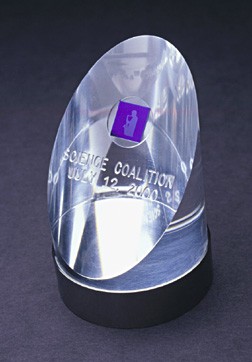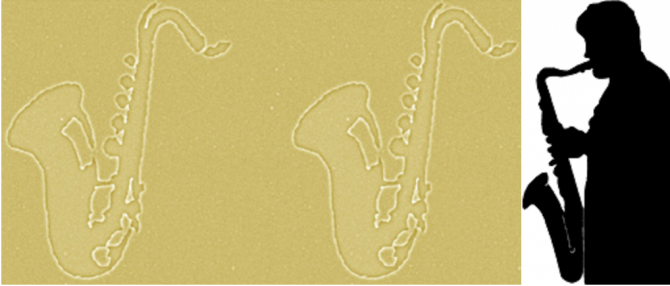To dramatize nanotechnology, Cornell gives President Clinton the world's smallest saxophone
By Bill Steele
WASHINGTON, D.C. -- In the wake of the nanoguitar, now there are 287,900 nanosaxophones.
The tiny instrument images, carved on a silicon chip by engineers at the Cornell Nanofabrication Facility, together form a centimeter-square silhouette of President Bill Clinton playing his favorite musical instrument. The unique chip, embedded in a lucite paperweight, will be presented to the White House staff today (Wednesday, July 12) by Hunter Rawlings, president of Cornell University.
"We are confident this is the smallest gift any president has ever received," Rawlings said. He will present the memento to John Podesta, Clinton's chief of staff, for inclusion in the Clinton presidential library.
Each of the tiny saxophone images is about 6-by-8 millionths of a meter, or about the size of a red blood cell. Carved onto a chip made of blue silicon nitride, they form the pixels of an image based on a photo of Clinton taken at his 1993 inaugural ball in Arkansas.
The nanosaxophone was made, Rawlings said, to illustrate the Cornell Nanofabrication Facility's ability to manufacture the world's smallest devices, used in biology, medicine, chemistry, electronics, optics and physics. The images were produced by an advanced technique called electron beam lithography, which can form objects about 10 times smaller than photolithography, the method used to make most computer chips today.
Cornell nanofabricators attracted worldwide attention in 1997 when a graduate student used similar techniques to carve a microscopic sculpture of a guitar onto a silicon chip. Although done as a lark, the nanoguitar was a dramatic demonstration of the potential of nanotechnology.
Rawlings will present the nanosaxophone as part of a daylong series of events sponsored by the Science Coalition, a consortium of universities and other research institutions formed to encourage continued federal support for basic research.
The nanosaxophone chip was created by Cornell Nanofabrication Facility staff members Richard Tiberio, Michael Skvarla, Karlis Musa and Melanie-Claire Mallison, and undergraduate research intern Teresa Emery. The paperweight in which it is mounted was crafted by the Advanced Design and Fabrication Facility of the Cornell University College of Engineering and designed by Michael Harding, director of the facility. The project was directed by Alton Clark, associate director of the Cornell Nanofabrication Facility.
Media Contact
Get Cornell news delivered right to your inbox.
Subscribe

